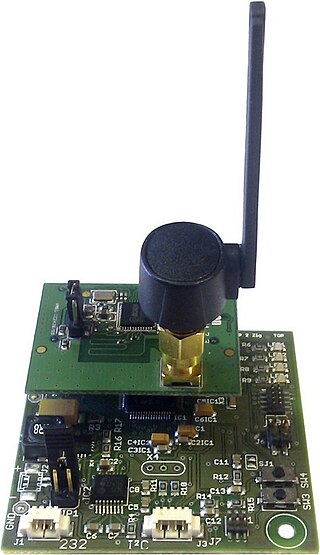
A wireless network is a computer network that uses wireless data connections between network nodes.
Zigbee is an IEEE 802.15.4-based specification for a suite of high-level communication protocols used to create personal area networks with small, low-power digital radios, such as for home automation, medical device data collection, and other low-power low-bandwidth needs, designed for small scale projects which need wireless connection. Hence, Zigbee is a low-power, low data rate, and close proximity wireless ad hoc network.

A wireless mesh network (WMN) is a communications network made up of radio nodes organized in a mesh topology. It can also be a form of wireless ad hoc network.

A mesh network is a local area network topology in which the infrastructure nodes connect directly, dynamically and non-hierarchically to as many other nodes as possible and cooperate with one another to efficiently route data to and from clients.

The Optimized Link State Routing Protocol (OLSR) is an IP routing protocol optimized for mobile ad hoc networks, which can also be used on other wireless ad hoc networks. OLSR is a proactive link-state routing protocol, which uses hello and topology control (TC) messages to discover and then disseminate link state information throughout the mobile ad hoc network. Individual nodes use this topology information to compute next hop destinations for all nodes in the network using shortest hop forwarding paths.
Wireless sensor networks (WSNs) refer to networks of spatially dispersed and dedicated sensors that monitor and record the physical conditions of the environment and forward the collected data to a central location. WSNs can measure environmental conditions such as temperature, sound, pollution levels, humidity and wind.
In a hierarchical telecommunications network, the backhaul portion of the network comprises the intermediate links between the core network, or backbone network, and the small subnetworks at the edge of the network.
A wireless ad hoc network (WANET) or mobile ad hoc network (MANET) is a decentralized type of wireless network. The network is ad hoc because it does not rely on a pre-existing infrastructure, such as routers or wireless access points. Instead, each node participates in routing by forwarding data for other nodes. The determination of which nodes forward data is made dynamically on the basis of network connectivity and the routing algorithm in use.

The Better Approach to Mobile Ad-hoc Networking (B.A.T.M.A.N.) is a routing protocol for multi-hop mobile ad hoc networks which is under development by the German "Freifunk" community and intended to replace the Optimized Link State Routing Protocol (OLSR).

A sensor node, consists of an individual node from a sensor network that is capable of performing a desired action such as gathering, processing or communicating information with other connected nodes in a network.
Cooperative diversity is a cooperative multiple antenna technique for improving or maximising total network channel capacities for any given set of bandwidths which exploits user diversity by decoding the combined signal of the relayed signal and the direct signal in wireless multihop networks. A conventional single hop system uses direct transmission where a receiver decodes the information only based on the direct signal while regarding the relayed signal as interference, whereas the cooperative diversity considers the other signal as contribution. That is, cooperative diversity decodes the information from the combination of two signals. Hence, it can be seen that cooperative diversity is an antenna diversity that uses distributed antennas belonging to each node in a wireless network. Note that user cooperation is another definition of cooperative diversity. User cooperation considers an additional fact that each user relays the other user's signal while cooperative diversity can be also achieved by multi-hop relay networking systems.
In radio, cooperative multiple-input multiple-output is a technology that can effectively exploit the spatial domain of mobile fading channels to bring significant performance improvements to wireless communication systems. It is also called network MIMO, distributed MIMO, virtual MIMO, and virtual antenna arrays.
Topology control is a technique used in distributed computing to alter the underlying network to reduce the cost of distributed algorithms if run over the resulting graphs. It is a basic technique in distributed algorithms. For instance, a (minimum) spanning tree is used as a backbone to reduce the cost of broadcast from O(m) to O(n), where m and n are the number of edges and vertices in the graph, respectively.

OCARI is a low-rate wireless personal area networks (LR-WPAN) communication protocol that derives from the IEEE 802.15.4 standard. It was developed by the following consortium during the OCARI project that is funded by the French National Research Agency (ANR):
IEEE 802.11s is a wireless local area network (WLAN) standard and an IEEE 802.11 amendment for mesh networking, defining how wireless devices can interconnect to create a wireless LAN mesh network, which may be used for relatively fixed topologies and wireless ad hoc networks. The IEEE 802.11s task group drew upon volunteers from university and industry to provide specifications and possible design solutions for wireless mesh networking. As a standard, the document was iterated and revised many times prior to finalization.

PowWow is a wireless sensor network (WSN) mote developed by the Cairn team of IRISA/INRIA. The platform is currently based on IEEE 802.15.4 standard radio transceiver and on an MSP430 microprocessor. Unlike other available mote systems, PowWow offers specific features for a very-high energy efficiency:
Nivis, LLC is a company that designs and manufactures wireless sensor networks for smart grid and industrial process automation. Target applications include process monitoring, environmental monitoring, power management, security, and the internet of things. The company is headquartered in Atlanta, Georgia, with additional offices in Romania, where much of its technology is developed. The company's product portfolio consists of standards-based wireless communications systems, including radio nodes, routers, management software and a software stack for native communications. Nivis hardware is operated by open source software.
A mobile wireless sensor network (MWSN) can simply be defined as a wireless sensor network (WSN) in which the sensor nodes are mobile. MWSNs are a smaller, emerging field of research in contrast to their well-established predecessor. MWSNs are much more versatile than static sensor networks as they can be deployed in any scenario and cope with rapid topology changes. However, many of their applications are similar, such as environment monitoring or surveillance. Commonly, the nodes consist of a radio transceiver and a microcontroller powered by a battery, as well as some kind of sensor for detecting light, heat, humidity, temperature, etc.
Time Slotted Channel Hopping or Time Synchronized Channel Hopping (TSCH) is a channel access method for shared-medium networks.
Associativity-based routing is a mobile routing protocol invented for wireless ad hoc networks, also known as mobile ad hoc networks (MANETs) and wireless mesh networks. ABR was invented in 1993, filed for a U.S. patent in 1996, and granted the patent in 1999. ABR was invented by Chai Keong Toh while doing his Ph.D. at Cambridge University.









